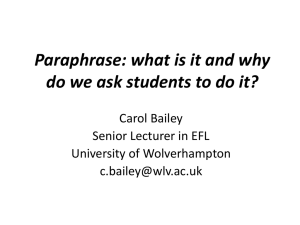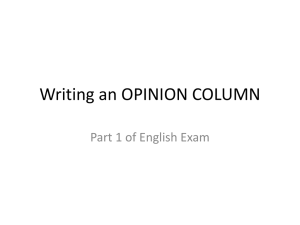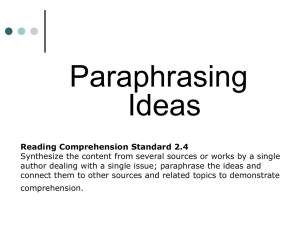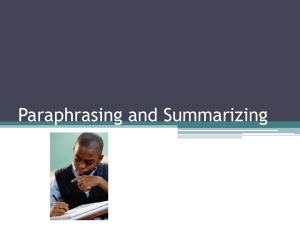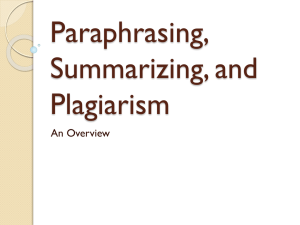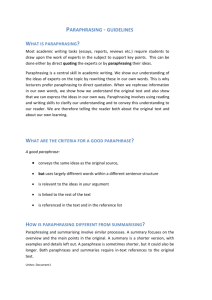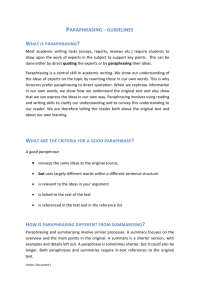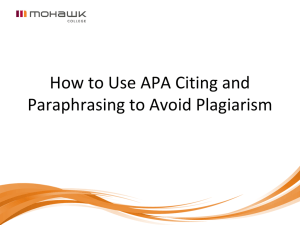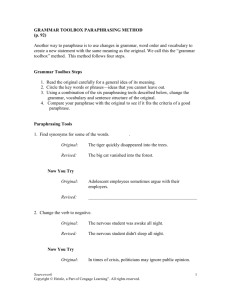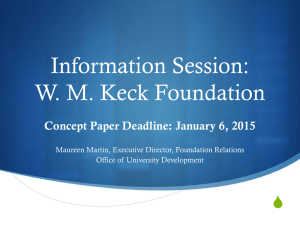ppt - College Writing Programs
advertisement
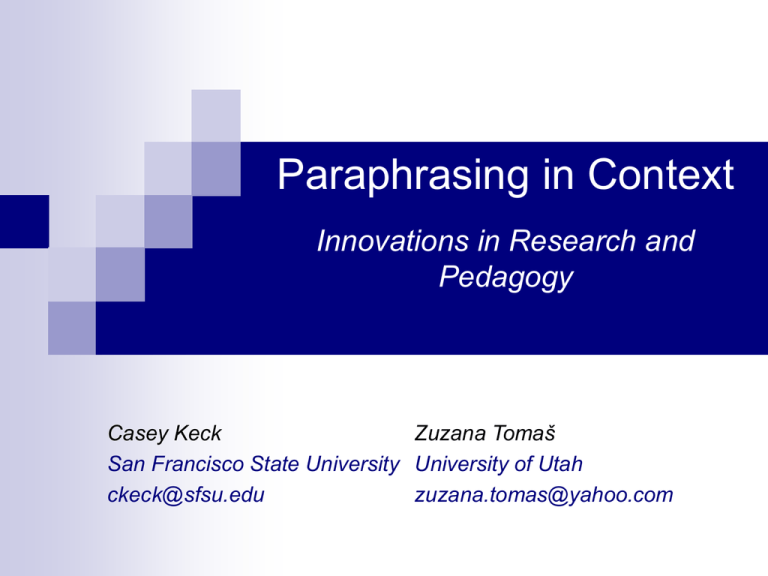
Paraphrasing in Context Innovations in Research and Pedagogy Casey Keck Zuzana Tomaš San Francisco State University University of Utah ckeck@sfsu.edu zuzana.tomas@yahoo.com Why are new approaches needed? Paraphrasing instruction is typically done in a decontextualized fashion. Example paraphrases are invented (i.e., they were not actually part of a larger academic text). Example paraphrases are labeled as “good” or “unacceptable,” though there is no empirical basis for making such judgments. Why are new approaches needed? Students are rarely shown paraphrases in the context of actual writing assignments. Teachers have a difficult time finding resources that discuss how and why writers paraphrase within specific genres or disciplines (Tomaš, to appear). New Approaches to Research Text-based descriptions of the strategies students use when completing academic tasks (Campbell, 1990; Keck, 2006; Pecorari, 2003; Shi, 2004). New Approaches to Research Investigation of factors that help to explain student strategy use (Keck, 2007; Shi, 2006, 2010): Cultural and educational background Language proficiency Nature of the writing task Disciplinary practices New Approaches to Research Investigation of the cognitive and linguistic challenges students face when attempting to integrate source texts into their own writing (Tomaš, in preparation). Important Research Findings Paraphrasing is a major academic writing strategy for university students (Campbell, 1990; Johns & Mayes, 1990; Keck, 2006; Pecorari, 2003; Shi, 2004). L1 and L2 writers Undergraduates and Graduates Important Research Findings Paraphrasing is a far more frequent strategy than exact copying (Keck, 2006). Students often use 3 or more strategy types within a one-paragraph summary. Near Copy Minimal Revision Moderate Revision Substantial Revision Important research findings Cultural background is only one of several factors that help to explain student strategy use (Keck, 2007; Shi, in press). Other important factors include: Nature of the writing task Educational experience Disciplinary practices Important research findings In sum, much of this work has helped us to rethink how we describe (or define) paraphrasing, as well as how we address this skill in writing courses. New approaches to pedagogy Addressing paraphrasing in the context of academic writing tasks Why might we paraphrase when writing a summary? An article response? A research paper? How can we draw upon our knowledge of the text, the assignment, and our discipline when making strategy choices? New approaches to pedagogy Complicating, rather than simplifying, the issue of plagiarism What role does textual borrowing play in academic writing development? Can we identify “good” types of borrowing? How do we distinguish effective borrowing from plagiarism? What criteria do we use to decide if a paraphrase is “acceptable” or not? Examples of new approaches Tardy, C. M. (2010). Writing for the world: Wikipedia as an introduction to academic writing. English Teaching FORUM. Tomas, Z. (to appear). Paraphrase integration task: Increasing authenticity of practice in using academic sources. College Writer’s Toolkit. Keck, C. (to appear). How do university students attempt to avoid plagiarism? Writing & Pedagogy, themed issue on Plagiarism and the Academy. An example unit Focus Paraphrasing in the context of summary writing Context Composition for Multilingual Students Second Year Composition (ENG 310) San Francisco State University Summary Unit Components Diagnostic summary task Reading strategy instruction Writing strategy instruction Group composing Paraphrasing Revision of original summary Application to a new summary task Diagnostic summary task 45-minute summary task Read 1,000 word text Write a one-paragraph summary Source texts Newsweek editorial “Where Have the Children Gone?” Identifies problem, causes, and effects Reading strategies Re-reading(s) of the text Group discussions of text structure and main ideas Strategies Dividing text into sections Annotation Graphic organizers Writing strategies Guided drafting Examples of useful summary expressions Strategies Drafting main idea statements Distinguishing main ideas from supporting details Reporting verbs & transitions Group composing Putting all of the pieces together (main ideas, examples, reporting verbs, transitions) Strategies Thinking aloud Making selection and integration decisions Paraphrasing Paraphrase judgment task Group composing, revisited Strategies Developing criteria for judging paraphrase acceptability and quality Reflecting on the function of paraphrases in a summary Summary Assignment Revise original summary from diagnostic task Apply strategies to a new summary task (new source text) Subsequent Assignments Summary & Response Paraphrasing focus: restating a claim made by the author, with appropriate agreement/disagreement language Synthesis of Multiple Sources Paraphrasing focus: note-taking, reporting research findings, in-text citation and reference lists Culminating Assignments Library research paper Similar in format to Synthesis Paper, but students choose topic and sources. In-class argumentative synthesis Similar to Summary and Response, but students respond to and evaluate multiple texts written on the same topic. Interested in reading more? Themed Issue of Writing & Pedagogy Plagiarism in the Academy Volume 2(2), 2010 To appear this summer Thank You!! Casey Keck Zuzana Tomaš San Francisco State University University of Utah ckeck@sfsu.edu zuzana.tomas@yahoo.com
